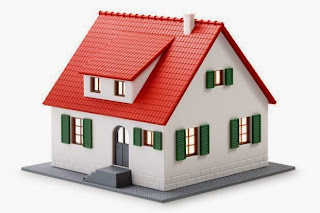
Here
are a few technical terms that will enable a borrower to clearly understand the
conditions and clauses connected with home loans:
Acceptance letter : Letter submitted by the borrower accepting the loan as per the terms
mentioned in the sanction letter.
Advance EMI : Number of equated monthly installments in the form of post dated cheques,
paid out in advance at the time of disbursement of loan.
Administrative fee : A onetime non-refundable fee, payable before the loan is disbursed. It
typically ranges between one and two percent of the loan amount
Amortisation schedule : This gives details of the principal and interest payments and the
amount outstanding at any given point during the amortization period. The
period of time for which a borrower owes interest and principal to his lender
is called the amortised period.
Annual rest : Here the EMIs are calculated on yearly basis. The interest is calculated
on the outstanding principal at the beginning of every year. Once the interest
is calculated at the rate charged to the customer for the entire year it is
deducted from the EMIs received during the year. The balance EMI is taken as
principal repaid during the year, and this is deducted from the opening
balance of the principal of the current year to arrive at the opening balance
of principal for the next year.
Appreciation: An increase in the value of a property due to changes in market conditions
or for other reasons.
Asset: An immovable or movable property or anything with a rupee value that you
own, which can be used as security against which credit can be offered.
Appraisal: A professional opinion of the current market value of a property.
Breach: Violation of any legal obligation is termed as breach.
Balloon loan : A loan that has a fixed rate of interest over a period of time. At the
end of the balloon period, the borrower must refinance or pay off the remaining
balance.
Bounce charges : Charges levied by the housing finance company in case cheques
submitted by the borrower get dishonored.
Collateral : Refers to an asset that can be used to guarantee the repayment of a loan.
The borrower risks losing that asset pledged as collateral if he defaults on
loan repayments.
Credit report : A report of an individual's credit history that is used by a lender to
determine a loan applicant's creditworthiness.
Co-applicant : A co-applicant applies for the loan jointly with you. It is usually the
spouse or parent, whose income can be clubbed with yours to enhance your loan
eligibility.
Deed : A legal document used to transfer the ownership of a property.
Default : Failure to meet legal obligations in a contract, in this case, failure to
make the monthly payments on a mortgage. If this happens, the borrower can end
up losing the property.
Down payment : Housing finance companies normally lend only 80-85 percent of the
value of the property. The balance, known as down payment would have to be paid
by the buyer, as a payment before he draws the loan amount.
Eligibility : Amount that can be lent to you by the bank based on your repayment capacity.
Your eligibility depends on the norms set by the bank and computation is based
on any of the following : loan to value ratio, installment to income ratio or
fixed obligation to income ratio.
Encumbrance certificate : Contains details of transfer of ownership of a property in
succession up to the current owner. It shows the date, the names of the parties
involving the amount of consideration, the extent and schedule of the property.
It can be procured from a sub-registrar's office for a fee.
Encroachment : An illegal intrusion onto someone else's property.
Equated monthly installments (EMI) : Loan repayments are usually in equal monthly
installments over the tenure of the loan.
Foreclosure : This is a legal process by which the lender or the seller forces a sale of a
mortgaged property because the borrower has not met the terms of the mortgage.
This is a measure for repossession of property if the borrower is unable to
keep up his financial commitments.
Fixed rate of interest : An option where the rate of interest remains fixed over the
tenure of the loan unless there are some clauses added. It is an ideal
alternative in situations when you expect the rates of interest to go
northwards.
Guarantee : A guarantee is an assurance by someone to pay a debt contracted by another if
the original party fails to pay according to a contract.
Income
to installment ratio : Used to compute loan eligibility, this ratio signifies
the percentage of the income that can be set aside for repayment of the loan
under the assumption that around 50 percent of the income is required by the
person for his own sustenance.
Interest rate : Rate at which the lenders charge interest for the loan amount.
Insurance for property : The insurance company protects the insured property against
specified losses, such as fire, windstorm and floods.
IRR : Internal rate of return is the rate at which the lender accounts for
interest.
License for construction : It is the permission in writing to construct that is issued
along with the loan application.
Lien: A legal claim against a property.
Lease : Contract by which the owner of an asset lets it out for use to another for a
specified time on payment of a specified amount called rental.
Loan to value ratio : The relationship between the amount of a loan and the
appraised value of the property, expressed as a percentage of the value.
Margin money : The difference in the total cost of the property and the loan amount
sanctioned is termed margin amount. This money has to be invested by the
borrower even before the loan amount is released.
Market value : Value of the property in accordance to the prevailing market rates.
Monthly rests : Here the balance amount is calculated on monthly basis. The EMI is
broken up every month to arrive at the opening balance of the principal for the
next month.
Mortgage: A legal document that pledges a property to the lender as security for
payment of a debt.
Penal interest : Penalty in the form of interest charged on installments if it is not
received as per the repayment terms by the end of the month.
Power of attorney : The power you can give a specified person or persons to act for
on your behalf. The person who is so represented is called principal. The
person who is so authorized to do or represent is called agent.
Pre EMI : Monthly repayments to the bank in the form of EMI for the loan will
begin only after the loan has been disbursed in full. Till such time the
borrower has to pay interest for the loan amount disbursed. This amount of
interest payable every month is called pre-EMI.
Prepayment: If a borrower has surplus funds he can pay back the loan either in parts or
in full. This is called prepayment. Some banks charge a pre-payment penalty
while others have a cap on the number of times that a person can prepay his
loan amount during a financial year.
Pre-payment penalty : This additional fee is charged by most banks in case the borrower
decides to pre-pay the loan before the tenure is over.
Refinancing : The decision to switch your loan from one lending institution to another is
called refinancing. People generally tend to switch when another lender
charges a much lesser interest rate.
Registration Value : This is the value of the property at which the property is registered.
Sale deed : An agreement in writing which transfers the ownership of the property
in exchange for a price paid. It is imperative that this document is
registered.
Sanction letter : On approval of the loan communication is sent by the lender to the
borrower. This letter conveys the sanction terms and conditions.
Survey : The determination of the exact boundaries and location of a property.
Tenure of loan : Number of years for which the loan is given.
Title: The right and interest over the property evidencing ownership. A title
deed is a statement, which confirms that the current owner legally holds title
to the property.
Valuation : Valuation is a professional assessment of the property's value, which is
required by the lender.
Underwriting: The process of evaluating a loan application to determine if the loan is
acceptable to the lender.







